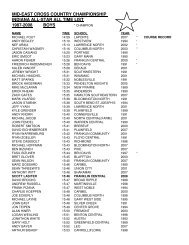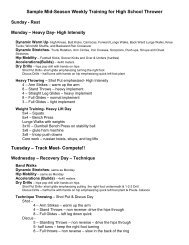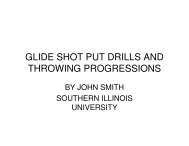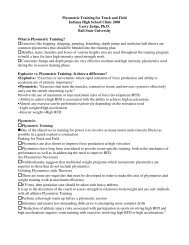Long Jump Approach & Take-off - iatccc
Long Jump Approach & Take-off - iatccc
Long Jump Approach & Take-off - iatccc
Create successful ePaper yourself
Turn your PDF publications into a flip-book with our unique Google optimized e-Paper software.
<strong>Long</strong> <strong>Jump</strong> <strong>Approach</strong> & <strong>Take</strong>-<strong>off</strong><br />
Jeff Martin<br />
Indiana State University Track & Field<br />
APPROACH<br />
<strong>Approach</strong> Length – Depends on the athlete’s ability, technical proficiency, chronological age<br />
and training age.<br />
- Beginners – keep approach short 6-7 steps (12 -14 total strides)<br />
- Intermediate – Start to lengthen approach 7-8 steps (14-16 total strides)<br />
- Advanced – <strong>Approach</strong> should be 8-9 steps (16-18 total strides)<br />
As the athlete becomes more proficient in the above areas, the approach will start to<br />
increase.<br />
How should the athlete perform the approach?<br />
-As the coach think of the approach in three phases!<br />
*Drive<br />
*Accelerate<br />
*Attack<br />
Things to think about when practicing the approach!<br />
- Athletes should never be at TOP speed at take-<strong>off</strong>. MAX controllable speed at<br />
take will lead to better jumps.<br />
- If the athletes gets up to speed to early he/she will slow down at take <strong>off</strong><br />
resulting in reaching which will lead to fouls or bad jumps<br />
- Athletes should never look at the board<br />
- Be sure the athlete has good posture<br />
- USE CHECK MARKS!!!<br />
Check marks for coaches are an easy way to make adjustments quickly!<br />
- Athletes use a check mark at the start of the run, if an athlete uses a mid check<br />
mark it should never effect the how the approach is performed.<br />
- Coaches should use a mid check step. This will allow you to gauge if the athlete<br />
is performing the drive & acceleration aspect of the approach correctly.<br />
- Penultimate step check can also be used.<br />
- MAKE ADJUSTMENT BASED ON HOW THE ATHLETE PEROFRMED THE<br />
APPOARCH NOT JUST ON WHERE THEY ARE AT THE CHECK MARKS!<br />
Notes:…….<br />
- <strong>Approach</strong> should be practiced early and often! (First week of practice)<br />
- Acceleration development is key to any horizontal jump approach<br />
- Practice the approach away from the runway<br />
- Since we jump in spikes, practice the approach in spikes<br />
- Don’t get too greedy!!!! Baby steps lead to BIG steps!<br />
- Train long jumpers as SPRINTERS!<br />
- Sprinters should be long jumping<br />
2013 IATCCC Clinic – Indianapolis, IN
TAKE-OFF<br />
When thinking of the take-<strong>off</strong>, think about what happens two steps out from take <strong>off</strong>. Most<br />
problems at the take-<strong>off</strong> can be a result from what happens the last 2 steps (4 strides) in<br />
the approach. In the attack phase of the approach this is where the most steering occurs. If<br />
the athlete is to far out from the mid check step he/she will lengthen their stride to reach<br />
the board. An athlete that is over the check step will then start to cut/chop their steps in<br />
order to not foul.<br />
When evaluating the preparation and take-<strong>off</strong> think of the following!<br />
- Athlete must have good posture. Head & pelvis should be aligned properly. You<br />
should not see the athlete leaning forward or backward<br />
- Correct running mechanics should be present.<br />
- Preparation for the take <strong>off</strong> will require the athlete’s center of mass to lower.<br />
This will help with the transition from horizontal velocity to vertical velocity.<br />
Preparation for take-<strong>off</strong><br />
- The penultimate step prepares the athlete for take-<strong>off</strong><br />
- The lowering of the COM should occur during the support phase of the<br />
penultimate step<br />
- Athlete should keep good posture during preparation<br />
- Think of this action as a pushing towards the board not a “dipping” action<br />
<strong>Take</strong>-<strong>off</strong><br />
- This should blend into the run/approach. Should not see any or much difference<br />
- <strong>Take</strong> <strong>off</strong> foot will be placed just in front of athletes COM.<br />
- Athlete should not lean forward or backwards at take-<strong>off</strong>. This will help<br />
maintain horizontal velocity.<br />
- The COM should continue in a horizontal path until it is over the take-<strong>off</strong> foot.<br />
Then the lifting effect should occur.<br />
- Make sure that athlete blocks other the drive knee and arm, this will help with<br />
converting the horizontal velocity created in the approach into vertical velocity<br />
at take-<strong>off</strong>.<br />
Notes:…….<br />
- Athlete should never slow down at the take <strong>off</strong><br />
- Accelerate throughout the take-<strong>off</strong><br />
- Athlete should be at MAX Controllable speed at take-<strong>off</strong>!!!<br />
- Cue I use for the prep & take-<strong>off</strong> is “Push-Pull”<br />
- For elite jumpers take-<strong>off</strong> angle will be 19-21 degrees<br />
- Prep & take-<strong>off</strong> should be practice early and often<br />
2013 IATCCC Clinic – Indianapolis, IN
Postural Integrity<br />
- Most over looked aspect in all movement.<br />
Bad posture will lead to mistakes that are very hard to correct/overcome in the jumping<br />
events.<br />
Throughout the entire long jump process, it is important that the athlete shows good<br />
posture!<br />
-This includes during the following<br />
- Running/warm-up drills<br />
- <strong>Long</strong> jump specific drills<br />
- <strong>Approach</strong> practice<br />
- Competition<br />
Coaches should work on the athlete’s core. Lower back and AB exercises are a must!<br />
Be sure you cue the athlete during warm-up, drills, competition, etc…to maintain good<br />
posture.<br />
<strong>Long</strong> <strong>Jump</strong> 6 Stride Check Mark Chart<br />
LJ <strong>Jump</strong> Dist. 6 Stride Mark Stride Length<br />
15’0 35’0 5’10<br />
15’6 35’6 5’11<br />
16’0 36’0 6’<br />
16’6 36’6 6’1<br />
17’0 37’0 6’2<br />
17’6 37’6 6’3<br />
18’0 38’0 6’4<br />
18’6 38’6 6’5<br />
19’0 39’0 6’6<br />
19’6 39’6 6’7<br />
20’0 40’0 6’8<br />
20’6 40’6 6’9<br />
21’0 41’0 6’10<br />
21’6 41’6 6’11<br />
22’0 42’0 7’<br />
22’6 42’6 7’1<br />
23’0 43’0 7’2<br />
23’6 43’6 7’3<br />
24’0 44’0 7’4<br />
24’6 44’6 7’5<br />
25’0 45’0 7’6<br />
(Each 1” stride length = 6” Mid-Mark & <strong>Jump</strong> Distance)<br />
Penultimate Step Check Marks<br />
Males – 2.2 to 2.4 meters<br />
Females – 2.0 to 2.2 meters<br />
2013 IATCCC Clinic – Indianapolis, IN

















